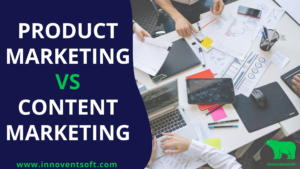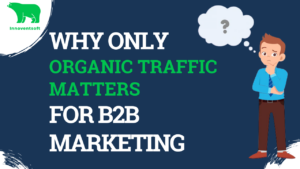If you think tracking the ROI of marketing activities is hard, you’re not alone.
Out of 1,000+ global marketers surveyed for HubSpot’s 2022 Marketing Industry Trends Report, 21% shared the same concern: demonstrating the ROI of marketing efforts is one of the biggest challenges they face in 2022.
Tracking the ROI is crucial for product marketing departments as it helps to understand the impact of marketing and aids in effectively spending the marketing budget. B2B marketing strategy focused on content marketing will need relevant marketing KPIs to understand how well a piece of content is performing and to allocate funds appropriately.
In this blog, we’ll cover 6 golden metrics (refer to the Innoventsoft platform screenshot below), which 500+ successful B2B brands and unicorns use, to track marketing effectiveness in their businesses.

1. Content Lead Time (CLT)
One of the primary KPIs, CLT, is the average time it takes to produce a piece of content, such as blogs, e-books, white papers, etc. If it takes 2 weeks for you to ideate, research, write, and publish a blog, then the lead time of that blog is 2 weeks.

CLT varies depending on the content type, but it has to match the industry standards to produce enough content and keep up with the competition.
However, rushing the content-making process and significantly reducing the lead time to outsmart your competitors is not ideal. It will only end up in low-quality content that will be detrimental to your content marketing strategy.
If your competitors are churning out substandard content in quick succession, you can increase the CLT and focus on quality instead of quantity. Finding a balance between less lead time and high-quality content can be tricky.
But you can use tools like ICM Platform to get a list of content topics that will resonate with your target audience. It will substantially reduce the time you’ll spend on researching what to write and help you quickly produce content that matters. The AI-based platform ensures the topics have enough search volume and match the user intent before optimizing them for SEO. It will help you produce quality content with less CLT and stand apart from the competition.
2. Content Velocity (CV)
CV is the number of pieces of content product marketers produce in a certain period. For example, publishing 3 blogs and 2 webinars in a month implies a content velocity of 5 per month.
It is important to have enough CV to provide a unified customer experience at different stages of their buying journey. Besides, the content has to be SEO-friendly for the target audience to find them easily.


Looking at your top competitors is a good way to start with content velocity. You can manually note their CV or use tools from Ahrefs, ICM Platform, or Semrush to get insights into how much content you need to produce.
Even after doing the competitor research, you should be mindful of the goal of your content strategy. If you’re new to the industry, you might want to increase your CV to bring more traffic and increase the Domain Authority (DA). The resources you have to produce content are another thing to consider. Surely, a team of 5 content creators can’t compete against a team of 20.
Content velocity should provide a balanced workload for the team, and writers shouldn’t compromise the quality of the content.
Product marketing teams can use various project management tools, such as JIRA, Asana, ICM Platform, and Git to organize and manage the entire process of producing and publishing content.
3. Brand Awareness
Brand awareness shows how familiar your brand is and it’s crucial in building trust with your target audience. If they become more familiar with your brand, the more they trust you and your products.
We can use 2 KPIs to measure the brand awareness of a B2B website: the number of impressions and the number of clicks. While impressions are the number of people eyeballing your content on Google or other channels, the number of clicks shows the number of unique visitors to your webpage. ICM Platform can provide you with this metric, and you can use it to analyze how well your brand is performing on Google searches.

A website with low impressions means your target audience is not engaging with your content, leading to fewer clicks. To make the target audience aware of your brand presence, you must create content and optimize them for more impressions and clicks.
You can use tools like ICM Platform to get a list of content topics that matter to your audience and get real-time suggestions to optimize them for SEO.
Apart from the number of impressions and clicks, analyzing social media engagement on sites like LinkedIn and Twitter will help B2B brands to measure brand awareness. Creating free content on websites and social media remains one of the best ways to increase brand awareness.
5. Audience Engagement
Audience engagement is one of the key KPIs to know whether your content is resonating with your target audience. You can use Google Analytics or ICM Platform to see the average number of people reading content on your website and understand what percentage of them find the content interesting.

For web content, you can use metrics, such as Pageviews, bounce rate, Time on Page, and user flow, to measure audience engagement effectively. Pageviews show how often a website receives traffic, and it depends on the content’s quality and the website’s user experience.
Bounce rate refers to the percentage of visitors who left the page instead of continuing because of poor-quality content or bad user experience. To increase audience engagement, you need to keep the bounce rate at the lowest and increase the Time on the Page (the time people spend on a page).
To analyze audience engagement on social media, you can track your content’s total reach on sites like LinkedIn and Twitter. It shows the number of unique users who have seen your content. Also, measuring the number of likes, comments, and shares will help you understand the engagement rate and customer sentiment.
Quality and engaging content that is properly optimized will increase audience engagement on your website and social media. Frequently monitoring audience engagement will help you produce more content that your readers will enjoy and significantly reduce the bounce rate.
5. Inbound Leads
Inbound leads are B2B prospects who engage with your content and initiate contact with you. They might have filled out forms on your website, downloaded a free e-book or guide, contacted sales regarding pricing queries, or requested a demo.

A good way to boost inbound leads is to write content addressing your target customer’s pain points. Empathize with your prospects’ problems and create content—blogs, videos, webinars, or case studies—aiming to solve them. You can create product-led content to present your product as the ideal solution to your audience, which will positively impact inbound leads.
Usually, B2B organizations use CRM tools like HubSpot and Salesforce to manage all lead records. You can use the ICM platform, a centralized monitoring tool for CXOs, to identify the trends and the number of form-fills that happened each month. ICM platform integrates with the CRM system of your choice, pulls data, and provides contextual information about percentage leads from the audience.
If you’re using HubSpot individually, a lead will appear as you see in the picture below. It shows Charlotte Arrowood, a lead acquired in July 2016, with several options to track and monitor.

A strong content call to action (CTA) is important to lead your audience into your sales funnel. For instance, include a CTA to download a free e-book in a blog post and send it to their email once they provide it. The contact information will help you to follow up and give them personalized offers based on their preferences.
Continuously monitoring your inbound leads metric will inform you whether the current inbound marketing strategy is working or needs to change.
6. Marketing-Qualified Leads (MQLs)
An MQL is a lead interested in your product or service and may soon become your customer. They have shown genuine interest in your product by filling out website forms and giving contact information, downloading free materials, or opting for a free trial.
Marketing qualified leads are not ready to buy from you yet. Your marketing and sales teams need to sync to make them fully committed. By analyzing the data provided by marketing, the sales team can check if the MQL passes the criteria to become an SQL (Sales Qualified Leads).
You can use HubSpot, Sales Cloud, or ICM Platform to track MQLs. By making it easier to connect with your preferred CRM systems, ICM Platform provides info regarding the number of nurtured leads and those qualified for sales.
The data helps to understand two things:
- how the website audience is gradually translating into a healthy sales pipeline, and
- whether additional efforts, such as email campaigns, are required to convert leads to MQLs.

In B2B marketing, an MQL needs to meet certain criteria regarding revenue, the total number of employees, and more, to become a potential SQL. Having criteria in place will help your sales team spend time on leads that matter.
Monitoring MQLs and their conversion to SQLs is a good way to understand the lead quality, and it shows how well your marketing strategy is performing. A healthy pipeline of high-quality leads is crucial to the success of any B2B product marketing strategy.
Also, the number of MQLs is a key metric for product marketers to make sound decisions regarding the type of content they need to produce.
Automating the process
Tracking the 6 golden metrics is all you need to understand the impact of product marketing on your business. However, manually tracking all the metrics can be tedious and consume too much time you can spend productively.
You can automate this using Innoventsoft’s ICM Platform to get real-time reports of the 6 metrics and make meaningful and faster decisions based on them. It will help you instantly calculate the ROI of your marketing channels and understand how well you spend each dollar. ICM Platform can seamlessly integrate with your third-party marketing tools, and it pushes data to track marketing KPIs regarding brand awareness and leads.

Besides, providing content marketing services has generated results for our clients and shown a significant increase in all 6 marketing KPIs. Feel free to request a demo, or start a free trial and take your content marketing strategy to the next level.





